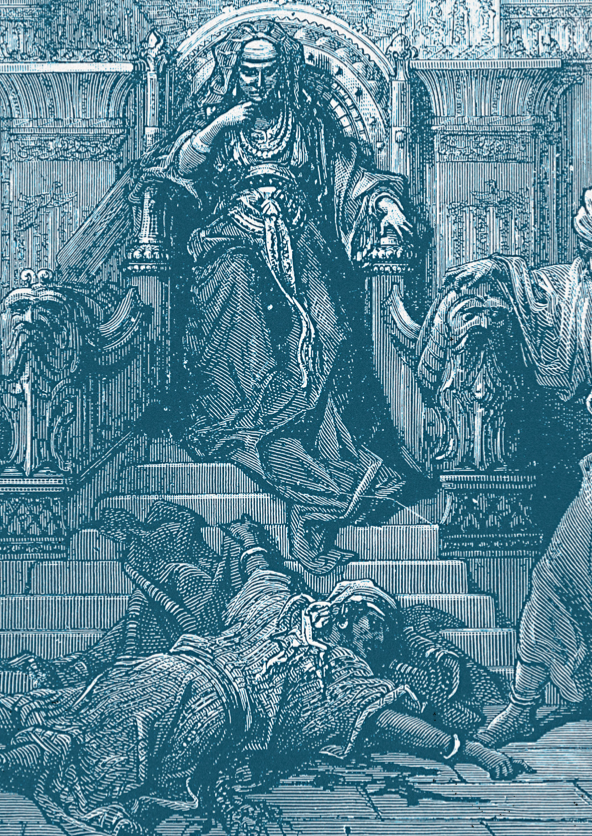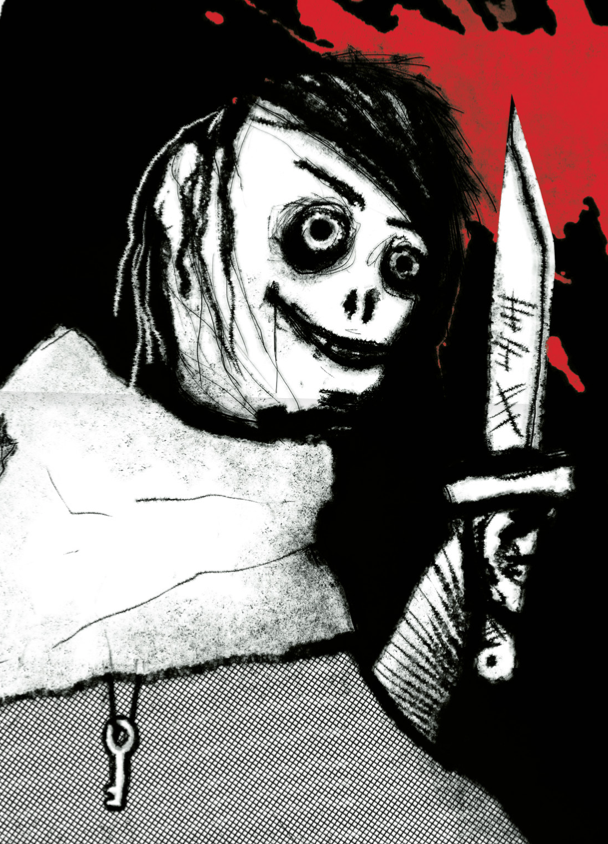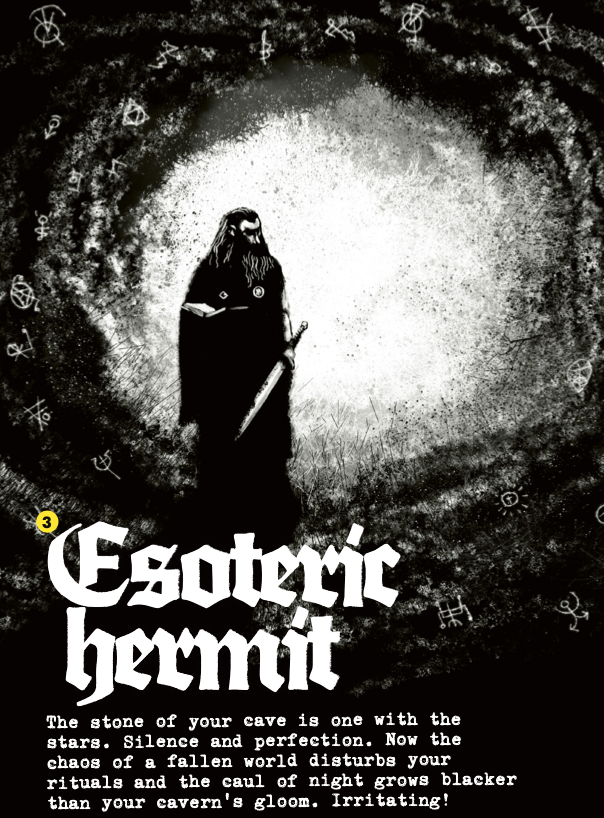A doom metal album of a game, a spiked flail to the face. Rules light, heavy everything else. This short description is featured on the back cover of the rulebook, and truly sets the tone for the world Pelle Nilsson and Johan Nohr sought to create. Since its release in 2019 MÖRK BORG has drawn hundreds of game masters and players to its dark black plague horror setting and system. The conclusion of GenCon and the announcements of the ENnie Award Winners saw MÖRK BORG taking home four awards. Those being Best Game where MÖRK BORG won silver, and then three gold awards for Best Layout and Design, Best Writing, and last but not least Product of the Year. After buying the book and running my first session during GenCon Online, it is all but clear why this system did so well.
Carving through the wrapping and taking a look at the cover, you are met with bright yellow and obscure black writing with the vivid depiction of an undead creature spattered in the blood of a recent kill. The book opens up to a series of tables. From a list of unisex names to treasures, traps a loot table, and my personal favorite, weather. The weather of the world could be anything from a lifeless grey to an irritating drizzle or grave-like cold which helps the game master really build the overall dreary mood of the setting. No light shines in the world you are trying to create, no hope of feeling the warmth of the sun on your skin as you venture through the dark and dreary landscape.
The Dying World
Following the tables is a brief call to action, or inaction rather. The world will come to an end, and there is little you or your fellow “adventurers” can do to stop it. All that matters is how you live in the days/weeks/months/years until the end. It also contains a brief history of the world, the coming of the Two-Headed Basilisk Lusi and Arkh who is revered as a god in the world and the creation of the world and how only one of her many children who were cast to their deaths survived. The book itself serves as a visual history of the regions of the world. Something to be appreciated in the history of the world and the descriptions of the regions is that it gives the players and the game master plenty of room to flex their homebrew muscles. The book gives plenty of description of the region, potential politics and key figures, but also is vague enough so any game master can take the information there and shape the world as they wish. From the mighty city of Galgenbeck to the Palace of the Shadow King, or the Valley of the Unfortunate Undead. The world can be as vast or as small as the game master wishes. The rulebook makes this obvious by stating “Distances shift. Paths between places warp. As if this pale, lightless world possessed a will and bitter life.” It feels very much like the Mists that bring players to Barovia in Curse of Strahd.
The most interesting feature of MÖRK BORG is The Calendar of Nechrubel or The Nameless Scriptures. “One be one, inevitable events demand their place.” In order of these events to take place a few things have to happen. First, the paty decides how long they want to play. From the end is nigh! (one night) to a bleak half-year or or years of pain. These range from rolling anywhere from a d2 to a d100. Each dawn in game the game master will roll the chosen die and if it results in a 1 it activates a Misery. The game master then rolls a d66, 2d6s similar to how you would roll a d100, and consult The Calendar of Nechrubel to determine which Misery is unleashed upon the world. The effects of the Misery then becomes a permanent feature in the world for the rest of the campaign, and as you continue to play more Miseries will be unleashed upon the world. After this happens six times, the seventh roll of a one unleashes the seventh misery. However, instead of rolling a d66 to see which is unlocked, You automatically unleash what is known as 7:7 or The Last. “All praise Yetsabu-Nech, the underworld’s nightmare, the black disk which stands before the sun! All praise Verhu, beaming with delight! All praise the fire which burns all! And the darkness shall swallow the darkness.” At this point the game, and the lives of your players’ characters end. At this point the players will create a new character, the world resets, and the game master would lead the party into another string of adventures and dungeon crawls.
Stocking Up
Next in the rulebook is equipment, and you can find a good variety of items, weapons, and armor to deck your character out in. You start by rolling on three separate tables which help to determine what kind of starting equipment you get. From there you move on to your weapons. Your class, or lack of one, determines which die you use to choose your starting weapon. You can get anything from a femur bone, to a bow or crossbow or the powerful zweihander (greatsword). One of my favorite pieces of art in the text is showcasing the weapons on a target. Another great aspect of the game is anything can be a weapon. You lose your shortsword, well there is a chair nearby you are able to pick up and swing WWE style for the same amount of damage as your shortsword. Armor and shields also has an interesting feature in MÖRK BORG. Instead of increasing your armor class like in Dungeons and Dragons, Armor in MÖRK BORG mitigates that amount of damage you take. Depending on the tier of armor you are wearing determines if you negate d2, d4, or d6 points of damage. Shields negate a static 1 point of damage, or can be “shattered” to ignore all damage from a single attack. The remaining equipment page shows items players can find either while traveling, or at shops while in a settlement or major city. It also included different services like spending the night at an inn, repairing armor, or bribing certain people around town. There is also a small table for animal companions whether it be a tamed rat, a mule or some kind of dog. The singular currency, silver, is used for everything and some items are priceless or worthless to the right individuals.
Powers & Omens
Powers are the spells and “arcane” arts that live in the world. These Powers are almost always found written on scrolls. There are two types of scrolls, Unclean and Clean. Unclean powers focus mainly on damaging or impairing foes, while Clean powers can be used to heal, commune with the other, or buff your party. There is some overlap between the two, bur for the most part the names speak for themselves. Anyone can use these scrolls, there is a limit on how many any player can use a day and activating the power requires both the scroll and a skill check. Included in the text is a fun arcane catastrophe table in case a player critically fails their check to cast the spell. This table can end terribly for the player, add some world building elements, or end with the player being devoured by HE the two-headed basilisk and son of SHE.
Another daily feature that players obtain is called Omens. Whether it is the eyes of Other powers, Eldritch beings, Fate, or the HE/SHE themselves, someone is watching over you. Each day the player rolls to see how many omens they have for the day. Omens can be used to deal maximum damage with a single attack, re-roll a die of your choice, lower damage taken by a d6, negate a critical success or failure, and finally can lower a test’s DC by 4 points. It is an extremely useful tool which helps ensure some survivability for your players. They have to manage this resource, because it is limited, and using one too early or too late, might lead to their own downfall.
Combat, Morale, & Taking A Break
The combat system in MÖRK BORG is relatively simple. If you don’t know how a creature or NPC will react to your players, there is a reaction table that you can roll to determine their mindsets. However, if you know combat is imminent get ready to roll initiative! This isn’t like D&D though, in MÖRK BORG the game master rolls a d6. Unless stated otherwise, on a 1-3 on the die the enemies take their turn(s) first and on a 4-6 the players take their turns first. If the players win initiative, they roll a d6 and add their Agility to the roll to determine their order. Alternatively, you could ask your player what order they would like to go in. Players wishing to attack the enemy can either make a melee attack using their Strength, ranged attacks with their Presence, or use a power after making a Presence check. Unless otherwise stated a player needs to make a DR12 on any of these in order to succeed and hit. The player then rolls their damage die. If the target is wearing armor, wearing a shield, or has some sort of natural armor, the game master rolls to see how much damage is negated, anything over what the game master rolled is taken by the target. Reversely, on the enemy’s turn, the game master will designate who is being attacked. Those players will roll an Agility test with a DR12, unless otherwise stated, to see if they avoid being hit. If they fail this check, they take the damage and can roll to see how much damage they mitigate if they are wearing armor.
During combat, Morale plays a big factor to the enemy. There are three factors that force the game master to roll for morale. If the leader of the enemies is killed, if half or more of the group of enemies is killed, or if a lone enemy has less than ⅓ HP left. You can just eyeball that last one if you aren’t good with math. After those conditions have been met, roll 2d6 and if the result is higher than the creature’s Morale you roll a second d6. On a 1-3 on the die the creatures flee. A result of 4-6 means the enemies surrender. If they get lower than their Morale, the fights to the death.
When combat is over, or the party is pretty beat up, they have a couple options for resting. They can either Catch Their Breath where they can heal a d4HP or they can get A Night’s Sleep where they can heal a d6HP. I would rule they can catch their breath a couple times a day, but can only get one night’s sleep a day.
Fated to Die
Now on the fun part, character building!! This is a pretty fun and straight forward process. There are six classes in the rulebook, as well as the option to go classless. The book has each class numbered so if you wanted to create it at random, you would roll a d6 and take what you rolled. There are four stats that every character has, strength, toughness, agility and presence. These four stats cover every aspect of the game and every skill check a person can do. Strength, agility, and toughness are your standard skills, while presence is pretty much a combination of a character’s intelligence, wisdom, and charisma.
The six classes of MÖRK BORG are the Fanged Deserter, Gutterborn Scum, Esoteric Hermit, Wretched Royalty, Heretical Priest, and Occult Herbmaster. Each class has a table to determine your origin to help develop a back story, your stat bonuses or class features, what to roll for your starting weapons and armor, and a random table that gives you your starting ability, item, or feature. Each class is unique in their own right, and provides multiple ways a player can utilize their abilities. Fanged Deserters are the closets to being the fighters and tanks of MÖRK BORG, able to use their long protruding teeth in combat to attack and hurt their prey. Gutterborn Scum the rogues who use their cunning and natural agility to stay out of sight and slink in the shadows. Esoteric Hermits, an eldritch caster of sorts, the solitary mage irritated by the dying world. Wretched Royalty, the mildly average noble who while wealthier than most is too proud for their own good. The Heretical Priest, a cultist hunted by the worshipers of the One True Faith. Last but not least, the Occult Herbmaster, a hedge witch who dabbles in the alchemical arts concocting potions and poisons.
The Creatures of the Dark
The pages that follow the character classes are a list of creatures the party can face. They range in typical fantasy fashion having monsters such as goblins, trolls, and wyverns. There are undead abound. Skeletons and zombies, wraiths and liches. Some creepy and distorted like the wickhead knife-wielder prowling the night. These are only a few and showcase the simplicity of the system while still having dynamic creatures to terrorize your party. There are even a few options for potential followers and outcasts who may join your party with enough persuasion. Scavengers, wild wickheads, the alien-like Pale One and lawless Prowlers who can offer things your party may need in exchange for protection. Everything in MÖRK BORG can be as friendly, or as dangerous as they seem.
The Dungeon Crawl and Adventuring Onward
The last portion of the rulebook contains your first dungeon crawl, Rotblack Sludge also known as The Shadow King’s Lost Heir. Without going into too much detail, or spoiling it for the reader, it is an amazing first dungeon crawl for a player or game master’s first experience with the system. The book gives you descriptions of the room, but really allows the game master to add their flavor to it. There are plenty of decisions for the players to make and tons of interesting spots for roleplay to occur naturally. There are also numerous chances for the players to feel the grittiness of the system and truly understand the meaning of “death to be waiting around every corner”. There is a clear narrative, but allows for player choice in determining how the story plays out. The system is so simplistic and minimalist anyone can run the adventure without fear. The game master does very little dice rolling and relies on setting the DC for checks and reacting to their players’ rolls.
After the dungeon, the final pages contain charts for creating your own adventures and dungeon crawls. The usefulness of these tables goes without saying and contains plenty of options to keep you adventures going. The final page ends with a cheat sheet that covers all aspects of the game and is invaluable as a resource for yourself and your players at the table.
As a final thought, MÖRK BORG is a land of blight and turmoil fraught with peril around every turn. Like any setting, the game is what the game master and their players make it. Enjoy the setting in all its grotesque horror and revel in the dark fantasy of the world. Good luck on all of your adventures and thank you for reading!
Meet the Blogger
Logan H. @dm_screening
Coalition Blog Director
Logan is a teacher from the Greater Philadelphia Area. A lifelong seeker of fantasy and adventure he spends his time writing campaigns and homebrews, going on adventures to local breweries, or reading all manner of tomes and scrolls to enhance his knowledge as a Dungeon Master.














